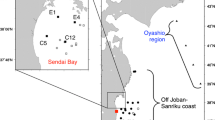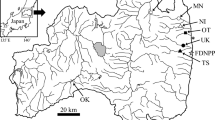Abstract
We investigated the dynamics of tritium (3H) from 2003 to 2012 in the marine environment off Aomori and Iwate prefectures. To better understand this radionuclide’s behavior, we compared 3H and 137Cs in collected samples. In the comparison, for the activity concentrations of 3H, these data excluded the period from 2006 to 2008 during intermittent test operation of the Rokkasho Nuclear Fuel Reprocessing Plant; for the activity concentrations of 137Cs, the data excluded the period from 2011 to 2012 after the Fukushima Daiichi Nuclear Power Station accident. The mean concentration ratio (CR) of tissue-free water tritium (TFWT) was close to 1.0, indicating that the concentration of this nuclide in marine biota was almost equal to that in seawater, and it therefore was not accumulated to high levels in marine biota. The lowest CR of 137Cs was higher than 30, suggesting that this nuclide was accumulated to relatively high levels in marine biota. Furthermore, the lack of correlations by Spearman’s test (R < 0.4, P > 0.05) between the CR of TFWT and that of 137Cs for three different species (Gadus macrocephalus, Lophius litulon, and Oncorhynchus keta) provides convincing evidence that the dynamics of TFWT and 137Cs in marine ecology are decoupled.










Similar content being viewed by others
Change history
15 September 2023
A Correction to this paper has been published: https://doi.org/10.1007/s10872-023-00705-5
References
Antovic I, Antovic NM (2011) Determination of concentration factors for Cs-137 and Ra-226 in the mullet species Chelon labrosus (Mugilidae) from the South Adriatic Sea. J Environ Radioact 102(7):713–717. https://doi.org/10.1016/j.jenvrad.2011.04.006
Furukawa F, Watanabe S, Kaneko T (2012) Excretion of cesium and rubidium via the branchial potassium-transporting pathway in Mozambique tilapia. Fish Sci 78:597–602. https://doi.org/10.1007/s12562-012-0492-6
Hayes DW (1976) Tritium in the Savannah River estuary and adjacent marine waters, United States.
IAEA (2004) TRS422 Sediment distribution coefficients and concentration factors for biota in the marine environment. https://www-pub.iaea.org/MTCD/Publications/PDF/TRS422_web.pdf Accessed 7 April 2023
IAEA (2010) TRS472 Handbook of Parameter Values for the Prediction of Radionuclide Transfer in Terrestrial and Freshwater Environments. https://www-pub.iaea.org/MTCD/Publications/PDF/trs472_web.pdf Accessed 7 April 2023
Janovics R, Bihari Á et al (2014) Monitoring of tritium, 60Co and 137Cs in the vicinity of the warm water outlet of The Paks Nuclear Power Plant, Hungary. J Environ Radioact 128:20–26. https://doi.org/10.1016/j.jenvrad.2013.10.023
Kasamatsu F, Ishikawa Y (1997) Natural variation of radionuclide 137Cs concentration in marine organisms with special reference to the effect of food habits and trophic level. Mar Ecol Prog Ser 160:109–120. https://doi.org/10.3354/meps160109
Kim SB, Bredlaw M et al (2019) Distribution of organically bound tritium (OBT) activity concentrations in aquatic biota from eastern Canada. J Environ Radioact. https://doi.org/10.1016/j.jenvrad.2019.105997
Kondo K, Kawabata H, Ueda S et al (2003) Distribution and dynamics of radionuclides and stable elements in the coastal waters off Rokkasho Village, Japan, prior to the opening of a nuclear reprocessing facility. J Radioanal Nucl 258(3):463–472. https://doi.org/10.1023/B:JRNC.0000011739.58313.b8
Kurita Y, Sakuma T et al (2021) Seasonal changes in depth and temperature of habitat for Japanese flounder Paralichthys olivaceus on the Pacific coast of northeastern Japan. Fish Sci 87(2):223–237. https://doi.org/10.1007/s12562-021-01495-9
Liu S, Liu Y et al (2022) Effects of oceanographic environment on the distribution and migration of Pacific saury (Cololabis saira) during main fishing season. Sci Rep. https://doi.org/10.1038/s41598-022-17786-9
Oikawa S, Takata H et al (2011) Distribution of the Fukushima-derived radionuclides in seawater in the Pacific off the coast of Miyagi, Fukushima, and Ibaraki Prefectures. Japan Biogeosciences 10(7):5031–5047. https://doi.org/10.5194/bg-10-5031-2013
Povinec PP, Aoyama M et al (2013) Cesium, iodine and tritium in NW Pacific waters–a comparison of the Fukushima impact with global fallout. Biogeosciences 10(8):5481–5496. https://doi.org/10.5194/bg-10-5481-2013
R Core Team (2022). R: A language and environment for statistical computing. R Foundation for Statistical Computing, Vienna, Austria. URL https://www.R-project.org/.
Shirotani Y, Inatomi N et al (2021) Distributions of tritium in the coastal waters off aomori and iwate prefectures. Fusion Eng Des. https://doi.org/10.1016/j.fusengdes.2021.112738
Takata H, Kumamoto Y (2022) Spatiotemporal variation of radiocesium in coastal and oceanic seawater. In: Nanba K, Konoplev A, Wada T (eds) Behavior of Radionuclides in the Environment III. Springer, Singapore
Takata H, Kusakabe M et al (2018) Appearances of Fukushima daiichi nuclear power plant-derived 137Cs in coastal waters around Japan: results from marine monitoring off nuclear power plants and facilities, 1983–2016. Environ Sci Technol 52(5):2629–2637. https://doi.org/10.1021/acs.est.7b03956
Takata H, Johansen M et al (2019) A 30-year record reveals re-equilibration rates of 137Cs in marine biota after the Fukushima Dai-ichi nuclear power plant accident: concentration ratios in pre-and post-event conditions. Sci Total Environ 675:694–704. https://doi.org/10.1016/j.scitotenv.2019.04.015
Tanaka H, Takasuka A et al (2008) Geographical variations in the trophic ecology of Japanese anchovy, Engraulis japonicus, inferred from carbon and nitrogen stable isotope ratios. Mar Biol 154(3):557–568. https://doi.org/10.1007/s00227-008-0949-4
Ueda H (2012) Physiological mechanisms of imprinting and homing migration in Pacific salmon Oncorhynchus spp. J Fish Biol 81(2):543–558. https://doi.org/10.1111/j.1095-8649.2012.03354.x
Ueda S, Kakiuchi H et al (2006) Tritium concentration in fresh, brackish and sea-water samples in Rokkasho-Village, Japan, bordered by nuclear fuel cycle facilities. J Radioanal Nucl Ch 267(1):29–33. https://doi.org/10.1007/s10967-006-0005-0
Ueda S, Hasegawa H, Kakiuchi H (2022) Tritium and iodine-129 in water samples collected adjacent to a spent nuclear fuel reprocessing plant in Rokkasho. Japan Radiat Prot Dosimetry 198(13–15):957–963. https://doi.org/10.1093/rpd/ncac019
Wada T, Fujita T et al (2016) Effects of the nuclear disaster on marine products in Fukushima: an update after five years. J Environ Radioact 164:312–324. https://doi.org/10.1016/j.jenvrad.2016.06.028
Wada T, Konoplev A et al (2019) Strong contrast of cesium radioactivity between marine and freshwater fish in Fukushima. J Environ Radioact 204:132–142. https://doi.org/10.1016/j.jenvrad.2019.04.006
Watabe T, Oikawa S et al (2013) Spatiotemporal distribution of 137Cs in the sea surrounding Japanese Islands in the decades before the disaster at the Fukushima Daiichi Nuclear Power Plant in 2011. Sci Total Environ 463–464:913–921. https://doi.org/10.1016/j.scitotenv.2013.06.031
Watanabe YW, Watanabe S, Tsunogai S (1991) Tritium in the northwestern North Pacific. J Oceanogr Soc Jpn 47:80–93. https://doi.org/10.1007/BF02301484
Acknowledgements
We thank the staff of the Marine Ecological Research Institute for their efforts in this study. We are also grateful for the helpful comments on the manuscript from the two anonymous reviewers. The marine environmental radioactivity survey is part of a research project contracted by the Japanese Ministry of Education, Culture, Sports, Science and Technology. This research was funded by a Japan Society for the Promotion of Science Grant-in-Aid for Scientific Research (B) (21H03574).
Author information
Authors and Affiliations
Corresponding author
Additional information
The original online version of this article was revised due to first, last names of all authors were published incorrectly and corrected in this version.
Supplementary Information
Below is the link to the electronic supplementary material.
Rights and permissions
Springer Nature or its licensor (e.g. a society or other partner) holds exclusive rights to this article under a publishing agreement with the author(s) or other rightsholder(s); author self-archiving of the accepted manuscript version of this article is solely governed by the terms of such publishing agreement and applicable law.
About this article
Cite this article
Ohtsuki, S., Shirotani, Y. & Takata, H. Distributions of tritium and 137Cs in coastal seawater and biota off Aomori and Iwate prefectures, Japan. J Oceanogr 79, 547–561 (2023). https://doi.org/10.1007/s10872-023-00697-2
Received:
Revised:
Accepted:
Published:
Issue Date:
DOI: https://doi.org/10.1007/s10872-023-00697-2




